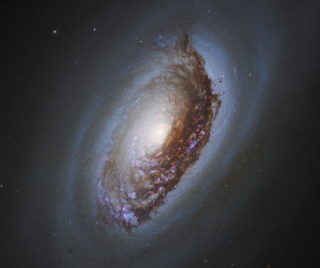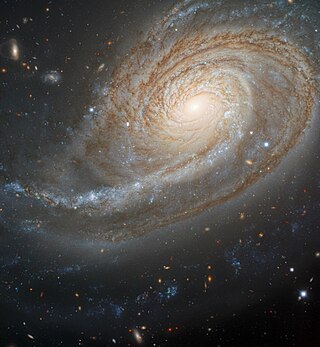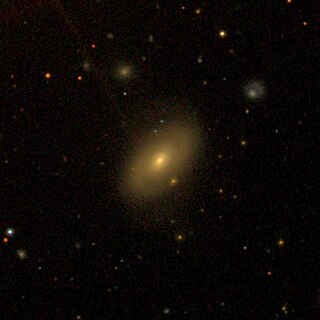
The Black Eye Galaxy is a relatively isolated spiral galaxy 17 million light-years away in the mildly northern constellation of Coma Berenices. It was discovered by Edward Pigott in March 1779, and independently by Johann Elert Bode in April of the same year, as well as by Charles Messier the next year. A dark band of absorbing dust partially in front of its bright nucleus gave rise to its nicknames of the "Black Eye", "Evil Eye", or "Sleeping Beauty" galaxy. M64 is well known among amateur astronomers due to its form in small telescopes and visibility across inhabited latitudes.

NGC 772 is an unbarred spiral galaxy approximately 130 million light-years away in the constellation Aries.

NGC 1169 is an intermediate barred spiral galaxy in the constellation of Perseus. NGC 1169 has a reddish center, indicating the region is dominated by older stars. In contrast, the outer ring contains larger blue-white stars, a sign of recent star formation. The entire galaxy is rotating at approximately 265 km/s.

NGC 322 is a lenticular galaxy located approximately 318 million light-years from the Solar System in the constellation Phoenix. It was discovered on September 5, 1834 by John Herschel. It was described by Dreyer as "very faint, very small, round, a little brighter middle, 3 stars to west." It apparently seems to be interacting with PGC 95427, another galaxy.

NGC 325 is a spiral galaxy located in the constellation Cetus. It was discovered on September 27, 1864 by Albert Marth. It was described by Dreyer as "very faint, very small".

NGC 328 is a spiral galaxy in the constellation Phoenix. It was discovered on 5 September 1836 by John Herschel. It was described by Dreyer as "very faint, a little extended, very gradually brighter middle, following (eastern) of 2", the other being NGC 323.

NGC 342 is a lenticular galaxy in the constellation Cetus. It was discovered on September 27, 1864 by Albert Marth. It was described by Dreyer as "very faint, very small."

NGC 345 is a spiral galaxy located in the constellation Cetus. It was discovered on September 27, 1864 by Albert Marth. It was described by Dreyer as "very faint, very small, gradually brighter middle."

NGC 347 is a spiral galaxy in the constellation Cetus. It was discovered on September 27, 1864, by Albert Marth. It was described by Dreyer as "very faint, very small."

NGC 349 is a lenticular galaxy in the constellation Cetus. It was discovered on September 27, 1864 by Albert Marth. It was described by John Louis Emil Dreyer as "very faint, very small."

NGC 361 is an open cluster in the Small Magellanic Cloud. It is located in the constellation Tucana. It was discovered on September 6, 1826, by James Dunlop. It was described by Dreyer as "very very faint, pretty large, very little extended, very gradually brighter middle." At an aperture of 31.0 arcseconds, its apparent V-band magnitude is 12.24, but at this wavelength, it has 0.40 magnitudes of interstellar extinction.

NGC 364 is a barred lenticular galaxy in the constellation Cetus. It was discovered on September 2, 1864, by Albert Marth. It was described by Dreyer as "very faint, very small."

NGC 373 is an elliptical galaxy located in the constellation Pisces. It was discovered on December 12, 1876 by John Louis Emil Dreyer. It was described by Dreyer as "very faint, very small."

NGC 410 is an elliptical galaxy located in the constellation Pisces. It was discovered on September 12, 1784 by William Herschel. It was described by Dreyer as "pretty bright, pretty large, northeastern of 2.", the other being NGC 407.

NGC 429 is a lenticular galaxy of type S0^0: located in the constellation Cetus. It was discovered on December 20, 1786 by William Herschel. It was described by Dreyer as "very faint, very small."

NGC 449 is a spiral galaxy of type (R')S? located in the constellation Pisces. It was discovered on November 11, 1881 by Édouard Stephan. It was described by Dreyer as "very faint, very small, round, very little brighter middle, very faint star involved."

NGC 7070 is a spiral galaxy located about 100 million light-years away in the constellation of Grus. It has a close companion galaxy called NGC 7070A. NGC 7070 was discovered by astronomer John Herschel on September 5, 1834.

NGC 3675 is a spiral galaxy located in the constellation Ursa Major. It is located at a distance of circa 50 million light years from Earth, which, given its apparent dimensions, means that NGC 3675 is about 100,000 light years across. It was discovered by William Herschel in 1788.

NGC 5363 is a lenticular galaxy located in the constellation Virgo. It is located at a distance of circa 65 million light years from Earth, which, given its apparent dimensions, means that NGC 5363 is about 100,000 light years across. It was discovered by William Herschel on January 19, 1784. It is a member of the NGC 5364 Group of galaxies, itself one of the Virgo III Groups strung out to the east of the Virgo Supercluster of galaxies.

NGC 765 is an intermediate spiral galaxy located in the constellation Aries. It is located at a distance of circa 220 million light years from Earth, which, given its apparent dimensions, means that NGC 765 is about 195,000 light years across. It was discovered by Albert Marth on October 8, 1864. The galaxy has an extensive hydrogen (HI) disk with low surface brightness, whose diameter is estimated to be 240 kpc.




















